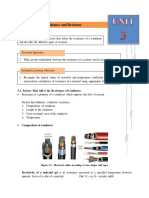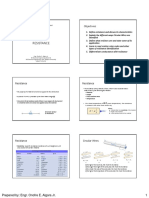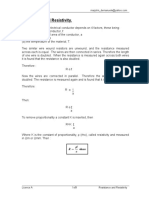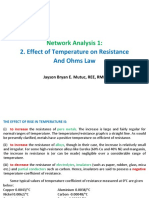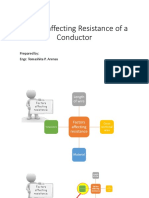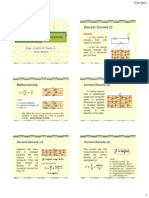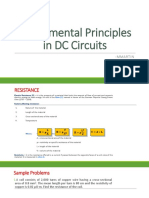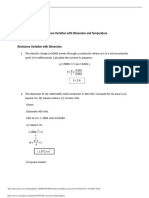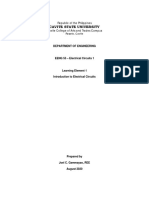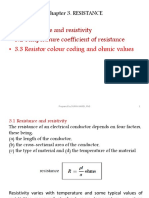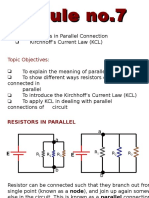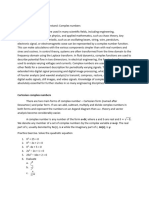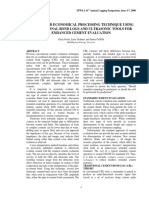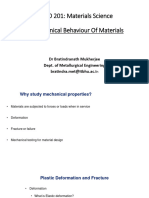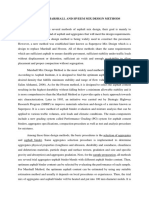Module no.
4
Contents:
The Resistance
The Effect of Temperature on the
Resistance
Resistor Color Coding
Work, Power, and Energy
Topic Objectives:
To define the meaning of resistance
To explain the effect of temperature on the
resistance of the wire
To identify the values of resistor using color
codes
To solve problems dealing resistor color coding
To differentiate energy from work and power
�RESISTANCE = the opposition to the flow of current (char
opposition
due to collisions and friction between fre
electrons
collision and friction
converts electrical energy into
FACTORS affecting resistance of material
1. Type of material ()
L_
2. Length (L)
R =
A
3. Cross sectional Area (A)
4. Temperature of the material (T)
where:
= CM / ft at T = 20oC (room temp)
= resistivity constant
L = length in feet
A = area in circular mils (CM)
�CIRCULAR MILS (CM)
mil = a unit of measurement for length
1 mil =
1__ inch (or 0.001inch)
1000
1000 mils = 1 inch
Circular mil vs. Square mil
By definition;
1 mil
1 mil
d = 1 mil
A = 1CM
A wire with a diameter
of 1 mil has an area
of 1 CM.
�Applying the definition to a wire having a diameter of 1 m
2
d
A =
4
Since
(1)
=
=
4
4
1 CM =
4
Therefore; 1 sq. mil
sq. mil = 1 CM
sq. mils
4
=
CM
So for a wire with a diameter of N mils,
A =
4
=
4
A = N2
(N)2 sq. mils
(N)2 4[
CM
CM ]
or ACM = (dmils)2
since d = N
�Sample Problems:
1. Find the area of a wire with a diameter of 1/8 inch.
2. What is the resistance of a 100ft length of copper wire
0.020 inch diameter at 20oC? ( at 20o = 10.37 CM /
3. An undetermined number of feet of wire have been us
with a diameter of 1/16 inch and the resistance is 0.5
What is the length of the wire? (same )
4. What is the diameter of a wire in inch, with an area of
6925CM?
�Temperature Effects on the Resistance of a copper wire
For good conductors, an
increase in temperature
will result in an increase in
the resistance level
R
(+) Temperature
coefficient
Temp
R
(-)Temperature
coefficient
Temp
http://www.electriccircuits.net/book,6,chapter,319,lesson,1470,thermoelectricity.aspx
Resistance Curve
R2
R1
X
(Absolute Zero)
-273.15oC
0C
-234.5oC
(Inferred Absolute Zero)
o
T1
T2
Using Similar Triangles
X = Y
R2
R1
/234.5/ + T2
/234.5/ + T1
=
R2
R1
Note: Inferred absolute temp varies depending on material
�Initial Temperature (Ti) of selected materials in oC
Silver
Copper
Gold
Aluminum
Tungsten
Nickel
Iron
- 234
234.5
274
236
204
147
162
General Equation:
/Ti / + T1
R1
/Ti / + T2
=
R2
�Sample Problems:
1. If the resistance of a copper wire is 50 at 20oC, what
resistance at 100oC?
2. If the resistance of a copper wire at freezing
temperature is
30, what is its resistance at -40 o C?
3. If the resistance of an aluminum at room
temperature
(20 oC) is 100m, at what temperature will it
become 120m?
�Temperature coefficient of resistance
Example: Observe how wire temperature affect wire
resistance
http://www.allaboutcircuits.com/vol_1/chpt_12/5.html
�At 20o Celsius, we get 12.5 volts across the load and a total of 1.5
volts (0.75 + 0.75) dropped across the wire resistance.
If the temperature were to rise to 35o Celsius, we could easily
determine the change of resistance for each piece of wire. Assuming
the use of copper wire ( = 0.004041) we get:
http://www.allaboutcircuits.com/vol_1/chpt_12/5.html
�http://www.allaboutcircuits.com/vol_1/chpt_12/5.html
�TEMPERATURE COEFFICIENTS OF RESISTANCE, AT 20 DEGREES C
Material
Element/Alloy
"alpha" per degree Celsius
==========================================================
Nickel -------- Element --------------- 0.005866
Iron ---------- Element --------------- 0.005671
Molybdenum ---- Element --------------- 0.004579
Tungsten ------ Element --------------- 0.004403
Aluminum ------ Element --------------- 0.004308
Copper -------- Element --------------- 0.004041
Silver -------- Element --------------- 0.003819
Platinum ------ Element --------------- 0.003729
Gold ---------- Element --------------- 0.003715
Zinc ---------- Element --------------- 0.003847
Steel* --------- Alloy ---------------- 0.003
Nichrome ------- Alloy ---------------- 0.00017
Nichrome V ----- Alloy ---------------- 0.00013
Manganin ------- Alloy ------------ +/- 0.000015
Constantan ----- Alloy --------------- -0.000074
�Resistor Color Coding
Scheme
There are three types of resistor color coding. They have
different number of color bands and hence provide
different information. This is illustrated by the next table.
You can calculate the value of an unknown resistor by
entering its color code in the fields below the table.
4-band color code
5-band color code 6-band color code
2 digits, multiplier,
tolerance
3 digits, multiplier,
tolerance
3 digits, multiplier,
tolerance,
thermal coefficient
http://www.breakup.de/resources/resistor.html
�How to read Resistor Color Codes
Black Brown Red OrangeYellow Green Blue Violet Gray
White
0
9
3
4
5
THE MNEMONIC
B - Bad
B - Boy
R - Ravish
2
O - Our
Y - Young
4
G - Girls
5
B - But
V- Violeta
7
G - Gave
8
W - Willingly9
67
8
Tolerance%
0
(Black)
Go
1
(Brown)
Sil
(Red)
No color - (20%)
3
(Orange)
(Yellow)
(Green)
6
(Blue)
(Violet)
(Gray)
(White)
http://xtronics.com/kits/rcode.htm
�http://users.etech.fh-hamburg.de/users/gelab/Html/Inhalte/resistor-color-code.htm
�Sample Problems:
Find the resistance value in ohms and the percent
tolerance of:
a) Red, Violet, Orange, Silver
b) Brown, Black, Brown, Silver
c) Green, Blue, Green, Gold
d) Red, Violet, Gold, Silver
e) Red, Violet, Black, Gold, Red
f) Yellow, Black, Red, Black, Brown
g) Orange, Orange, Red, Orange, Green
Give the color code for each value of resistor
a) 3305%
b) 2.2k10%
c) 100k5%
d) 510%
�We are now ready to analyze
circuits of different configurations





